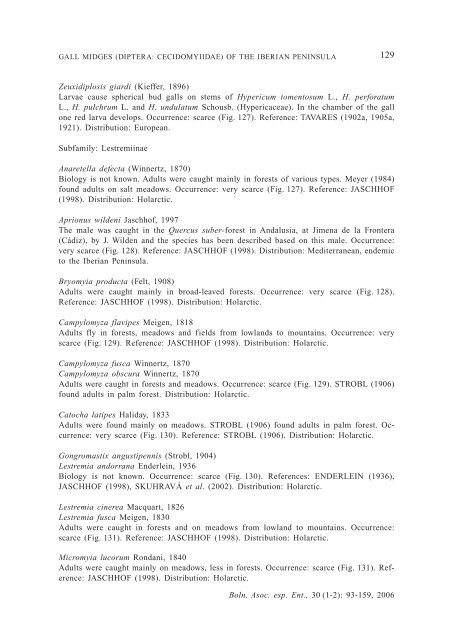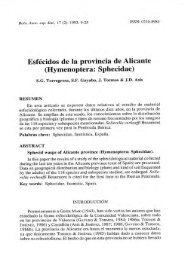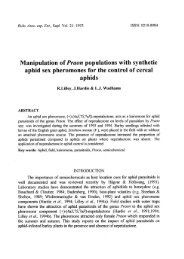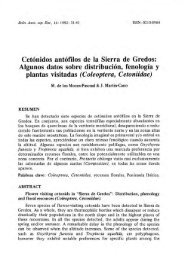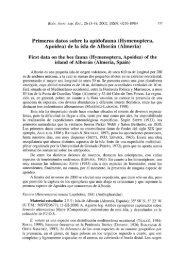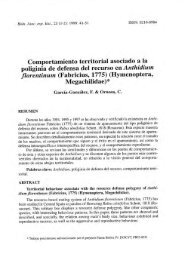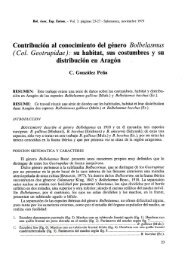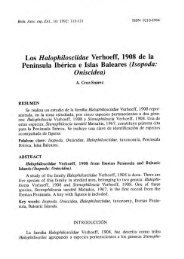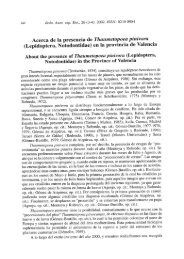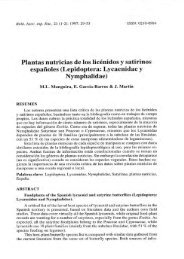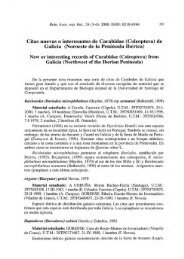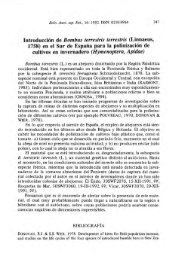Libro 1.indb
Libro 1.indb
Libro 1.indb
You also want an ePaper? Increase the reach of your titles
YUMPU automatically turns print PDFs into web optimized ePapers that Google loves.
GALL MIDGES (DIPTERA: CECIDOMYIIDAE) OF THE IBERIAN PENINSULA 129<br />
Zeuxidiplosis giardi (Kieffer, 1896)<br />
Larvae cause spherical bud galls on stems of Hypericum tomentosum L., H. perforatum<br />
L., H. pulchrum L. and H. undulatum Schousb. (Hypericaceae). In the chamber of the gall<br />
one red larva develops. Occurrence: scarce (Fig. 127). Reference: TAVARES (1902a, 1905a,<br />
1921). Distribution: European.<br />
Subfamily: Lestremiinae<br />
Anaretella defecta (Winnertz, 1870)<br />
Biology is not known. Adults were caught mainly in forests of various types. Meyer (1984)<br />
found adults on salt meadows. Occurrence: very scarce (Fig. 127). Reference: JASCHHOF<br />
(1998). Distribution: Holarctic.<br />
Aprionus wildeni Jaschhof, 1997<br />
The male was caught in the Quercus suber-forest in Andalusia, at Jimena de la Frontera<br />
(Cádiz), by J. Wilden and the species has been described based on this male. Occurrence:<br />
very scarce (Fig. 128). Reference: JASCHHOF (1998). Distribution: Mediterranean, endemic<br />
to the Iberian Peninsula.<br />
Bryomyia producta (Felt, 1908)<br />
Adults were caught mainly in broad-leaved forests. Occurrence: very scarce (Fig. 128).<br />
Reference: JASCHHOF (1998). Distribution: Holarctic.<br />
Campylomyza flavipes Meigen, 1818<br />
Adults fly in forests, meadows and fields from lowlands to mountains. Occurrence: very<br />
scarce (Fig. 129). Reference: JASCHHOF (1998). Distribution: Holarctic.<br />
Campylomyza fusca Winnertz, 1870<br />
Campylomyza obscura Winnertz, 1870<br />
Adults were caught in forests and meadows. Occurrence: scarce (Fig. 129). STROBL (1906)<br />
found adults in palm forest. Distribution: Holarctic.<br />
Catocha latipes Haliday, 1833<br />
Adults were found mainly on meadows. STROBL (1906) found adults in palm forest. Occurrence:<br />
very scarce (Fig. 130). Reference: STROBL (1906). Distribution: Holarctic.<br />
Gongromastix angustipennis (Strobl, 1904)<br />
Lestremia andorrana Enderlein, 1936<br />
Biology is not known. Occurrence: scarce (Fig. 130). References: ENDERLEIN (1936),<br />
JASCHHOF (1998), SKUHRAVÁ et al. (2002). Distribution: Holarctic.<br />
Lestremia cinerea Macquart, 1826<br />
Lestremia fusca Meigen, 1830<br />
Adults were caught in forests and on meadows from lowland to mountains. Occurrence:<br />
scarce (Fig. 131). Reference: JASCHHOF (1998). Distribution: Holarctic.<br />
Micromyia lucorum Rondani, 1840<br />
Adults were caught mainly on meadows, less in forests. Occurrence: scarce (Fig. 131). Reference:<br />
JASCHHOF (1998). Distribution: Holarctic.<br />
Boln. Asoc. esp. Ent., 30 (1-2): 93-159, 2006


